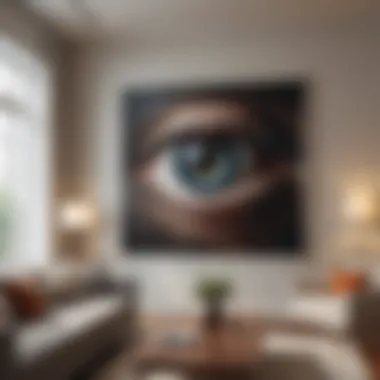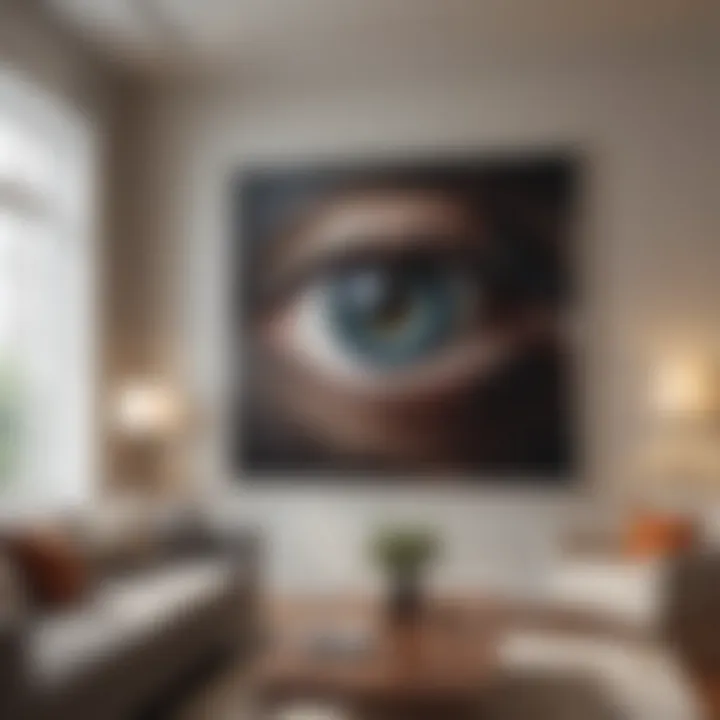Optimal Height for Hanging Artwork: Guidelines


Intro
Hanging artwork is not just about finding the perfect piece; it is equally about choosing the right height for display. The placement of art can alter perceptions of space and create focal points in both residences and commercial spaces. This becomes crucial whether you are enriching a living room wall or adding character to an office hallway.
Understanding the nuances of height can lead to more informed decisions. There are various factors that play a role in the optimal height for hanging artwork, such as the viewer's line of sight, the function of the space, and the type of artwork being displayed. Each of these factors requires consideration and adds to the overall visual harmony of the environment.
As we delve deeper into this topic, we will explore practical guidelines and try to highlight the importance of creating an appealing art display that resonates with personal and artistic expression.
Understanding the Importance of Picture Height
Picture height plays a fundamental role in how artwork is perceived and appreciated within a space. Proper placement of art can enhance not only the visual impact but also affect the mood and atmosphere of a room. When pictures are placed at an optimal height, they can connect more effectively with the viewer. Thus, understanding the significance of picture height is vital in both residential and commercial settings.
Correctly hung artwork contributes to an overall harmonious environment. This is particularly true in spaces meant for gathering, such as living rooms or galleries. In these areas, art should invite interaction and spark conversation. Additionally, well-placed pictures can lead to a positive emotional response, reinforcing the connection between art and its audience.
In a commercial context, the strategic positioning of artwork can influence customer perceptions. Heightened awareness of art placement can impact customer behavior positively, enhancing their experience. Such insights are relevant for business owners aiming to cultivate a welcoming and stimulating atmosphere.
Psychological Effects of Picture Placement
The psychological effects of picture placement are profound and often overlooked. The height at which a piece of art is displayed can affect viewers' emotional states and their overall connection to the artwork. Research indicates that art hung at eye level creates a sense of intimacy. This is key in encouraging engagement. When individuals have to strain their necks to view artwork, discomfort can overshadow the intended emotional impact.
Moreover, art can communicate messages and evoke feelings that might not be immediately apparent. For example, hanging a powerful piece lower than usual might elicit a sense of accessibility, while placing it high might provoke feelings of aspiration. Artists and designers recognize that these subtleties shape the way art is perceived.
- Place larger pieces slightly above eye level for impact.
- Ensure smaller artworks are at eye level to invite a closer look.
The end goal is to create a resonant experience. Understanding how height influences psychology helps in achieving this.
Impact on Room Aesthetics
The aesthetic quality of a room is heavily influenced by the placement of artwork. When art is positioned thoughtfully, it promotes a cohesive look and feel, turning a commonplace space into a well-designed area. Height contributes to this aesthetic but must be considered alongside other visual elements, such as furniture and color palettes.
When artworks are arranged correctly:
- They draw the eye, making the space feel more inviting.
- They balance between various elements, ensuring nothing feels out of place.
A well-hung piece can act as a focal point, anchoring the room's design. Conversely, artwork that is incorrectly placed can disrupt flow, causing an unbalanced appearance. Therefore, adhering to general guidelines is essential.
"The right height transforms art from mere decor to a source of inspiration."
Standard Guidelines for Picture Height
Understanding the standard guidelines for picture height is central to achieving a well-curated gallery that not only enhances the aesthetic of a room but also aligns with ergonomic principles. When artworks are hung at optimal heights, they can engage viewers more effectively and create a sense of harmony in a space. Properly placed art serves as a focal point, drawing the eye and enhancing the overall atmosphere. This section will outline essential guidelines, emphasizing the significance of standardized practices for hanging artwork in various contexts.
The Eye Level Principle
The eye level principle is one of the most cited rules when it comes to picture height. It suggests that artwork should generally be hung at an average eye level, allowing viewers to appreciate the piece without straining their necks. In most cases, this average eye level tends to be around 57 to 60 inches from the floor. This measurement is based on typical human sightlines and is ideal for most artworks, particularly paintings and photographs.
However, individual variations do exist. Factors like the height of the furniture, the types of space, and the arrangement of the room can influence what might be considered 'eye level' for a specific location. Thus, while the eye level principle serves as a reliable guideline, it shouldn't be applied in a rigid manner. Adapting the hanging height according to the room dynamics can yield entirely different outcomes that are more satisfying and visually appealing.
General Recommendations for Various Settings
When deciding on picture height, consider the setting. Different environments have distinct requirements that can affect the optimal height for displaying artwork. Here are some key recommendations for various types of spaces:
- Living Rooms and Galleries: For living spaces, opt for the standard eye level height to ensure that guests can view pieces comfortably. In galleries, it is often suggested to hang pieces slightly higher, around 60 to 66 inches, to accommodate various viewer heights.
- Kitchens and Dining Areas: In dining rooms and kitchens, art can be positioned lower since these rooms often focus more on engagement and conversation. Aim for 48 to 54 inches from the floor, ensuring it complements the surrounding decor and does not interfere with functionality.
- Bedrooms and Private Spaces: Art in bedrooms can be personalized. Depending on the headboard or bed height, artworks can be placed lower or higher but generally should not exceed 60 inches to maintain intimacy in the space.
- Hallways and Transitional Areas: Artwork in hallways tends to be viewed quickly, so hanging pieces a bit higher—64 to 68 inches—can draw attention without overwhelming the passersby.
- Commercial Spaces and Offices: In workplaces, consider the eye level principle but also think about the work being done in these spaces. A height of 60 to 65 inches can offer a professional aesthetic while fostering an inviting environment.
By taking into account these general recommendations, one can create an artwork display that resonates well within its environment, promoting interaction and visual appreciation.
Key Note: Adjusting the height of artwork to fit various settings can significantly enhance viewer experience and integrate art more naturally into a space's design.


Special Considerations for Different Rooms
Understanding the optimal height for hanging artwork cannot be isolated from the specific context of each room. Each environment possesses distinct characteristics and serves different purposes, impacting how artwork is perceived and enjoyed. A well-curated art display should accommodate these factors to enhance overall atmosphere and functionality.
Living Rooms and Galleries
In living rooms and galleries, the height of artwork should invite engagement. Most often, these spaces are designed for social interaction. Therefore, hanging art at eye level encourages conversation and connection among visitors. This generally translates to an average hanging height of 57 to 60 inches from the floor to the center of the artwork.
Moreover, the size of the room and the height of the ceilings can influence this decision. In larger or more spacious rooms, slightly higher placements can create a dramatic effect, whereas in smaller living spaces, lower placements can make the area feel more cohesive.
Kitchens and Dining Areas
Kitchens and dining areas are functional spaces that benefit from a more practical approach to art placement. Here, the height should ensure that art is visible yet not obstructive. For instance, when displaying artwork above countertops or dining tables, it is crucial to maintain a clearance of at least 12 to 18 inches. This allows for both safety and the enjoyment of artwork while engaging in everyday activities. Bright, colorful pieces can stimulate appetite and enhance the overall dining experience.
Bedrooms and Private Spaces
In bedrooms and private spaces, the atmosphere often leans towards tranquility and comfort. The height of artwork here can be more personal, reflecting the inhabitant's style and preferences. Generally, hanging art slightly lower than in public areas, around 54 to 57 inches from the floor may create a cozy and intimate vibe. Consideration of bed height and furniture arrangement is essential to avoid visual clutter and to maintain a serene environment.
Hallways and Transitional Areas
Hallways and transitional areas, often overlooked, can use thoughtful artwork placement to create an inviting atmosphere. The height for hanging artwork in these spaces should typically be at eye level, similar to living rooms. It is also advisable to maintain a consistent height when placing multiple pieces. This continuity creates flow and leads the viewer through the space effectively. Uniquely framed pieces, along with well-curated gallery walls, can transform otherwise mundane passageways into an enjoyable journey.
Commercial Spaces and Offices
In commercial spaces and offices, art placement requires a balance between professional ambiance and personal expression of the brand's identity. Generally, hanging artwork at eye level remains the standard, but considerations will also include the type of work being done in these spaces. In quieter areas, artwork may hang slightly higher for artistic impact while common areas can follow traditional height guidelines. Incorporating local or personal artwork can enhance company culture and offer warmth in otherwise sterile environments.
The thoughtful placement of artwork should enhance rather than detract from the function and character of each room.
Factors Affecting Optimal Hanging Height
Understanding the factors that affect optimal hanging height is crucial for achieving an aesthetically pleasing and functional display of artwork. The interplay of physical space, such as room dimensions and furniture arrangement, with psychological impact should be considered to create an environment that enhances both art and living spaces. Adjustments to hanging height can transform how art interacts with the viewer, invites engagement, and complements interior design.
Ceiling Height and Room Proportions
Ceiling height plays a significant role in determining how high pictures should be hung. In spaces with higher ceilings, such as foyers or great rooms, there is often a temptation to hang artwork too high. This can lead to a disconnection between the viewer and the artwork, making it feel less intimate. To optimize the viewing experience, consider the proportion of the room.
When dealing with high ceilings, artwork can be placed at or slightly above eye level, while also considering the vertical plane. In cases of exceptionally tall spaces, larger pieces or groupings of art can help fill the area effectively while maintaining visual coherence.
Another aspect to this consideration is the relationship between room proportions and visual weight. A well-proportioned room, when paired with artwork that carries considerable visual weight, should reflect balance on the wall. For example, placing larger pieces at greater heights allows them to dominate the space adequately, whereas smaller pieces may require lower placement to remain engaging.
"When hanging art, always consider what is around it to ensure a balanced display."
Furniture and Spatial Considerations
Furniture arrangement is another crucial element when determining artwork height. The relationship between furniture and art creates a sense of flow and hierarchy in a room. If artwork is placed above a piece of furniture, like a sofa or console table, it is typically recommended to leave about 6 to 12 inches of space between the top of the furniture and the bottom of the artwork. This distance allows for visual continuity and helps the viewer connect with both elements together.
Furthermore, consider how traffic patterns and sight lines within a room affect art placement. In corridors or entryways where people frequently move, placing art out of reach or too high could impede natural flow and interaction with the pieces. In contrast, in spaces designed for relaxation, such as lounges, art can be slightly higher if it draws attention towards the ceiling, enhancing the expansive feel of the room. These spatial considerations can greatly influence the viewer's experience and the overall ambiance of the setting.
Adjusting Height for Artwork Size and Orientation
In the realm of interior design, the height at which artwork is displayed is crucial. Adjusting it according to the size and orientation of the pieces can significantly influence the viewer's experience. This section addresses the importance of matching artwork dimensions with proper hanging height. Such considerations create visual harmony while ensuring that artworks are appreciated for their aesthetic value.
Small vs. Large Artwork
When hanging smaller pieces, the impact can diminish if placed too high. Generally, smaller artworks are best displayed at a lower height. This proximity makes them more inviting to viewers. Aim for around 57 to 60 inches from the floor's surface to the center of the piece. Displaying them earthier emphasizes their details and invites a closer look.
On the other hand, larger artworks often benefit from being elevated. Their grand scale naturally draws attention. Hanging them higher can create a sense of expansiveness in the room. Yet, it's recommended to maintain some connection to surrounding elements. When hanging large pieces, ensure that the bottom aligns with larger furniture like sofas or heads of beds. Avoid placing them too far above eye level.
Framed vs. Unframed Pieces
The framing of artwork plays a crucial role in its visual impact. If the artwork is framed, it often needs more height due to its added bulk. A framed piece can alter the overall perception of the art. The frame contextualizes the art within the space. Therefore, the area it occupies should reflect that. Framed pieces are usually effective when positioned closer to the central viewing height of 57 to 60 inches.


However, unframed artworks can appear less formal and may stand lower to the wall. This positioning gives an informal style that may suit specific spaces better. Also, unframed artworks interact more fluidly with the environment. They can feel approachable and inclusive.
Adjusting height for artworks based on their size and framing allows for optimal appreciation of the art itself, contributing to overall room aesthetic and coherence.
Ultimately, achieving a balanced visual presentation requires thoughtful consideration of both size and framing. It influences how the pieces communicate with their surroundings.
Consider experimenting with heights and groupings before committing to a final position. This flexibility allows for personalized adjustments that align with one's unique taste and the room's ambiance.
Hanging Multiple Pieces of Artwork
Hanging multiple pieces of artwork is a nuanced task that requires careful consideration of various elements to achieve a harmonious visual presentation. This approach can significantly enhance the atmosphere of a space while expressing personal style. It is essential to approach multi-piece displays with a clear strategy to create an engaging yet cohesive environment.
Benefits of Hanging Multiple Pieces
- Visual Interest: A well-arranged collection of artworks brings depth to a space and maintains the viewer's engagement.
- Personal Expression: Curating a gallery wall allows individuals to showcase their tastes and experiences through art.
- Enhanced Spatial Dynamics: Multiple pieces can redefine how a room is perceived, adjusting light and shadow interplay and contributing to a room's character.
However, achieving these benefits requires adherence to certain guidelines and a keen awareness of the overall aesthetics of the space in question.
Creating a Cohesive Gallery Wall
A gallery wall can serve as the centerpiece of a room, combining various artworks into a single, visually appealing display. To create this effect:
- Choose a theme or style: This can range from color schemes to subject matters, aiding in unity.
- Use a consistent frame style: Frames that share a similar color or design can tie different pieces together, minimizing visual chaos.
- Plan the layout: Before placing anything on the wall, consider laying the pieces on the floor to visualize their arrangement. Symmetry, asymmetry, or grid patterns can drastically affect the visual outcome.
Ensuring that pieces are hung at the right height is critical for a cohesive look. The midpoint of the artwork, or the center of the gallery wall, should typically fall around eye level, approximately 57 to 60 inches from the floor. Adjustments may be necessary based on ceiling height or the specific furniture arrangement.
Maintaining Visual Balance Across Spaces
Visual balance is a crucial yet often overlooked aspect when considering multiple artworks. Striking the right balance involves several considerations:
- Color Coordination: Ensure that the artwork complements the room's palette. This can create fluidity across areas.
- Size Variations: Mixing sizes can add variety but requires mindful placement. Larger art pieces can anchor a space, while smaller ones add detail.
- Spacing: Consistent spacing between pieces prevents clutter. A common guideline is to maintain a distance of 2 to 4 inches between framed works.
Utilizing these principles helps maintain harmony throughout a space, contributing to an overall better atmosphere.
In summary, hanging multiple pieces of artwork is not just about decoration; it is an art form in itself. With thoughtful placement and coordination, one can transform any wall into a gallery that reflects personal aesthetic while enhancing the environment.
Common Mistakes in Picture Hanging
Hanging artwork might seem straightforward, but many people overlook essential factors that can drastically affect the visual impact of their displays. Common mistakes in picture hanging can detract from the intended aesthetic and emotional experience of a room. Understanding these pitfalls is crucial for anyone looking to enhance their space through art. Avoiding these blunders can lead to a more harmonious and appealing presentation that aligns with one’s style and the room’s function.
Hanging Too High or Too Low
One pervasive mistake is positioning artwork either too high or too low. Many individuals, driven by the desire to showcase their pieces prominently, often forget the significance of eye level in creating an engaging visual experience. When art is hung too high, it risks becoming part of the background rather than serving as a focal point. This can create a disconnect between the viewer and the artwork, reducing its emotional and visual impact.
On the other hand, hanging pieces too low can also disrupt the flow of a room. When art is set below eye level, it may feel cramped or cluttered. This is particularly true in spaces that serve multiple functions, like living rooms or open areas. For optimal placement, a good guideline is to center artwork at approximately 57 to 60 inches from the floor. This height correlates closely with average eye level and helps create a natural line of sight.
"Art is meant to be seen; positioning it properly allows its full effect to shine."
Ignoring Room Dynamics
Another error often made is failing to consider room dynamics when hanging artwork. The architecture and overall design of a space play a significant role in how artwork is perceived. Failing to recognize the flow of the room or the placement of furniture can lead to a disjointed experience. For instance, placing a large piece of art over a sofa can be visually striking if done correctly. However, if the dimensions are not aligned with the surrounding furniture or decor, it can easily overwhelm the space.
Moreover, the color palette and light sources in a room should inform art placement. A bright, airy room may benefit from vibrant, lively pieces at eye level, while a smaller, more intimate space might call for subtler tones and lower placements to maintain warmth. A well-curated art display can accentuate room dynamics and enhance the overall atmosphere, turning a simple space into something special.
Tools and Techniques for Proper Hanging
Hanging artwork may seem simple, yet the proper tools and techniques can significantly enhance both the aesthetic appeal and the structural integrity of your displays. A well-hung piece can evoke emotions, draw the eye, and create a cohesive environment. To achieve these effects, having the right tools at your disposal and understanding their use is paramount.


First, measuring accurately is essential. If you fail to measure correctly, even the most beautiful artwork may look misplaced or awkward. Additionally, using the right types of hanging aids ensures that the artwork stays secure and maintains its intended appearance over time. Therefore, investing in appropriate tools enhances the overall display and saves future hassle.
Measurement Tools and Techniques
Measurement is at the forefront of any successful artwork hanging project. The first step is to gather accurate measurements of both the wall space and the artwork. Here are essential considerations:
- Tape Measure: A standard tape measure is an obvious choice but should be used with precision. Measure the height and width of both the wall space and the artwork to ensure proper placement.
- Level: Once you mark where to hang the piece, a level is critical for ensuring it hangs straight. A crooked piece could detract from its impact.
- Pencil: To mark your measurements lightly on the wall ensures you won’t forget where to place the artwork. Use a pencil that can be easily erased afterward.
- Stud Finder: If you’re hanging heavier pieces, it’s advisable to locate wall studs. This tool will help you find support behind the drywall, allowing for a more secure hang.
Utilizing these measurement tools correctly can lead to a smoother hanging process and a more polished outcome overall.
Hanging Aids and Hardware
Once measurements are complete, selecting the appropriate hanging aids is the next crucial step. Here are several options that help with different weights and styles of artwork:
- D-Rings: These are useful for hanging mediums with a bit of weight. They anchor securely to the back of the frame and can distribute weight evenly.
- Picture Hangers: Sodium hooks come in various weight ratings. These provide a simple method for hanging and are easily removed without damaging the wall surface.
- Wall Anchors: For heavier pieces or when you cannot find a stud, wall anchors provide extra support by spreading out the load.
- Command Strips: For a less permanent solution, especially in rented spaces, Command strips work well for lightweight frames and can be removed cleanly.
Using the right hanging aids according to your artwork's weight and the wall condition will ensure the pieces remain securely hung while maintaining the integrity of your walls. This careful consideration facilitates not only practicality but also enhances the visual experience of your displays.
"Proper tools and techniques in artwork hanging not only enhance aesthetics but also ensure longevity and security."
By equipping yourself with the appropriate tools and understanding the techniques related to measurements and hanging aids, you lay the groundwork for a successful and aesthetically pleasing art display.
Personalizing Your Art Display
Personalizing your art display is a fundamental aspect of creating a cohesive and inviting environment in both residential and commercial spaces. Art is not merely decorative; it provides insight into your personality and taste. Tailoring your artwork arrangement allows for a unique expression that resonates with your experiences and values. The personalization process takes into account several factors including style, theme, and emotional significance.
Incorporating personal style involves selecting pieces that reflect your aesthetic preferences. For instance, someone attracted to minimalist design might opt for clean lines and neutral colors. In contrast, a collector of vibrant folk art would prefer eclectic arrangements full of color and energy. When curating your collection, consider the emotional response each piece evokes. Engaging with art at this level transforms a simple display into a narrative about who you are.
Incorporating Personal Style
When incorporating personal style into your artwork display, the connection between the space and the pieces is critical. Choose artwork that harmonizes with the decor and contributes to the overall atmosphere. For example, if your space features rustic elements like exposed wood beams, you might choose landscape paintings that reflect natural settings. Conversely, sleek, modern artwork would suit a contemporary setting with clean lines and metallic accents.
Additionally, art can be used to create thematic zones within a room. A series of black-and-white photographs can establish a gallery-like feel in a hallway, while bold abstracts can define an energetic vibe in a shared living space. The placement of art should also consider traffic flow. Visitors’ pathways and sightlines should be unobstructed, allowing them to appreciate the artwork without distraction.
Evolving Your Collection Over Time
Evolving your collection over time keeps the display fresh. As tastes change or new pieces are acquired, rethinking your arrangement can breathe new life into a space. Sometimes, a piece might be rotated out based on seasonal themes or altered room dynamics.
Consider integrating local artists or exhibitions into your collection. This not only supports the artistic community but also adds layers to your narrative. As you evolve your collection, take a moment to reflect on why each piece is meaningful. Each artwork tells a part of your story, and by refreshing your selections, you continue to add to that narrative.
Key Takeaway: Personalizing your art display is about more than just aesthetics; it embodies your identity and connects your experiences to your environment.
Ending and Final Recommendations
The concluding section of this article is significant as it synthesizes the various insights provided throughout. Understanding the optimal height for hanging artwork is not merely about adhering to aesthetic standards; it is a matter of enhancing both personal and communal spaces. In the earlier sections, we explored the psychological impact, the room dynamics, and the various settings where artwork is displayed. Each factor plays a crucial role in ensuring that art serves its intended purpose while providing visual pleasure.
A key element to remember is the importance of context. Different environments influence the best height for displaying artwork. For instance, a gallery setting may call for a different approach compared to a cozy living room. The considerations about audience engagement—specifically, how viewers interact with the artwork—should inform the height choice. The guidelines presented, such as the eye level principle and spatial considerations, aim to strike a balance between personal preference and general recommendations.
Reviewing Key Takeaways
To summarize, remember the following key points when determining the height for your artwork:
- Aim for Eye Level: Generally, the center of your artwork should be at eye level, which averages around 57 to 60 inches from the floor.
- Consider Room Proportions: Higher ceilings may allow for higher placements, adding a sense of grandeur to the space.
- Account for Furniture Positioning: Ensure the artwork is not overshadowed by furniture. Plan art placement around your existing decor.
- Tailor to Artwork Size: Larger pieces may work better at a lower height, drawing the eye in, while smaller works can be placed higher without losing visibility.
- Be Mindful of Location: Different spaces demand different approaches. A hallway might require a more uniform arrangement, while a gallery could encourage a more dynamic layout.
Incorporating these elements will help in creating a well-thought-out art display. The process should not feel rushed but appreciated, allowing for personal nuances that reflect your style and the message of the artwork.
Encouraging Thoughtful Art Placement
Encouraging thoughtful placement of artwork goes beyond just hanging pictures. It is an exploration of aesthetics, interaction, and personal preferences. When you take the time to assess and re-evaluate where your artwork resides, you might open up new conversations within your space. Consider factors such as light exposure, wall color, and even the traffic patterns in the room when deciding on artwork placement.
- Interact with the Space: Walk around and visualize how you interact with your art. Whether standing, sitting, or walking past it, see how it influences your experience of the room.
- Adjust Based on Viewing Angle: Some artworks may look different from various distances or angles. Adjust your hanging height accordingly to ensure that the artwork is appreciated from all perspectives.
- Be Open to Change: Art is dynamic. As you acquire new pieces or change your design preferences, be willing to adapt your displays. Re-evaluating pieces every few years can keep your space feeling fresh.
By fostering a thoughtful approach to art placement, you contribute to a greater appreciation for the artworks themselves and heighten the ambiance of your living space. Taking these recommendations into account fosters a deeper connection between art and environment, enhancing overall visualization and experience.







